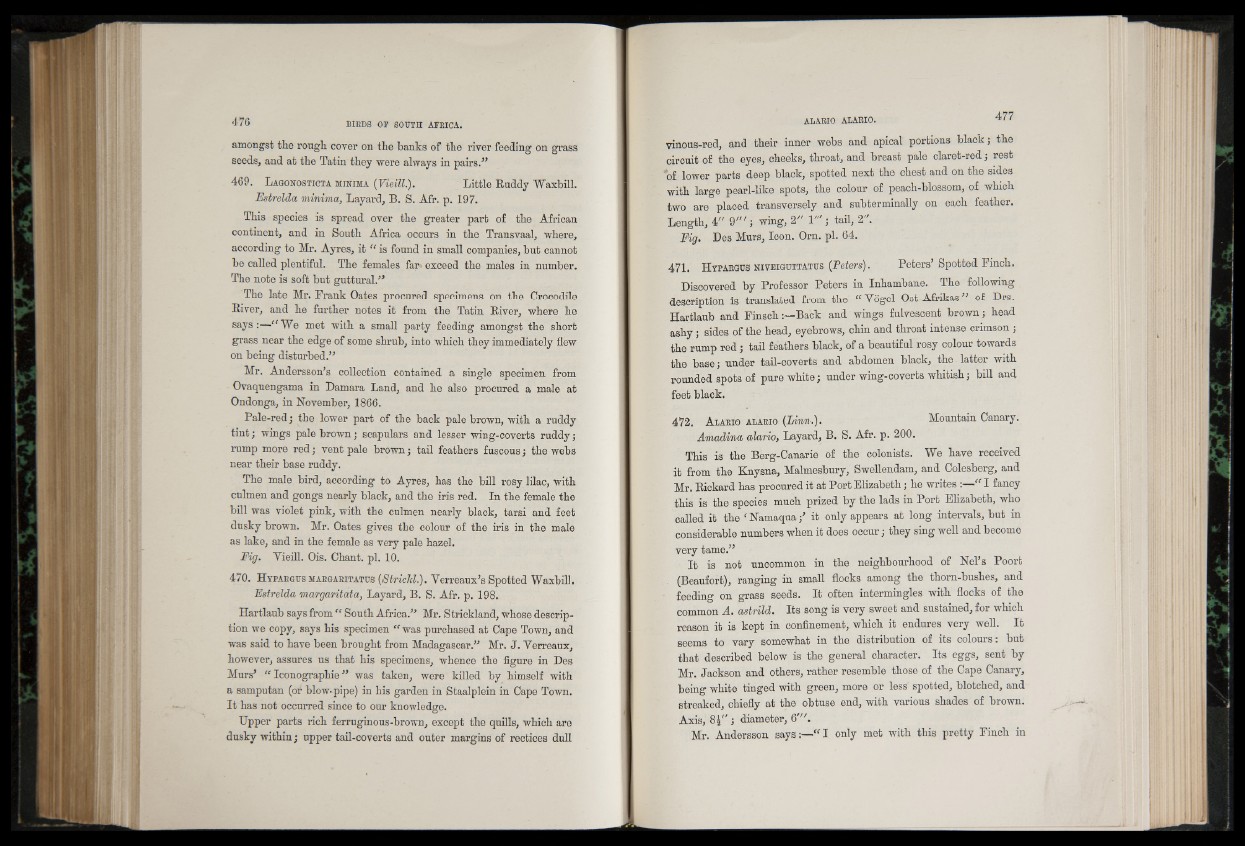
amongst the rough cover on the banks of the river feeding on grass
seeds, and at the Tatin they were always in pairs.”
469. L agonosticta m inim a (Vieill.). Little Ruddy Waxbill.
Estrelda minima, Layard, B. S. Afr. p. 197.
This species is spread over the greater part of the African
continent, and in South Africa occurs in the Transvaal, where,
according to Mr. Ayres, it ** is found in small companies, but cannot
be called plentiful. The females far> exceed the males in number.
The note is soft but guttural.”
The late Mr. Frank Oates procured specimens on the Crocodile
River, and he further notes it from the Tatin River, where he
says:—“ We met with a small party feeding amongst the short
grass near the edge of some shrub, into which they immediately flew
on being disturbed.”
Mr. Andersson’s collection contained a single specimen from
Ovaquengama in Damara Land, and he also procured a male at
Ondonga, in November, 1866.
Pale-red; the lower part of the back pale brown, with a ruddy
tint; wings pale brown; scapulars and lesser wing-coverts ruddy;
rump more red; vent pale brown; tail feathers fuscous; the webs
near their base ruddy.
The male bird, according to Ayres, has the bill rosy lilac, with
culmen and gongs nearly black, and the iris red. In the female the
bill was violet pink, with the culmen nearly black, tarsi and feet
dusky brown. Mr. Oates gives the colour of the iris in the male
as lake, and in the female as very pale hazel.
Fig. Vieill. Qis. Chant, pi. 10.
470. H ypargus margaritatus (Strichl.). Verreaux’s Spotted Waxbill.
Estrelda margaritata, Layard, B. S. Afr. p. 198.
Hartlaub says from “ South Africa.” Mr. Strickland, whose description
we copy, says his specimen “ was purchased at Cape Town, and
was said to have been brought from Madagascar.” Mr. J. Verreaux,
however, assures us that his specimens, whence the figure in Des
Murs’ “ Iconographie ” was taken, were killed by himself with
a samputan (of blow-pipe) in his garden in Staalplein in Cape Town.
I t has not occurred since to our knowledge.
Upper parts rich ferruginous-brown, except the quills, which are
dusky within; upper tail-coverts and outer margins of rectices dull
vinous-red, and their inner webs and apical portions black; the
circuit of the eyes, cheeks, throat, and breast pale claret-red; rest
#of lower parts deep black, spotted next the chest and on the sides
with large pearl-like spots, the colour of peach-blossom, of which
two are placed transversely and subterminally on each feather.
Length, 4” 9 '" ; wing, 2" 1" '; tail, 2".
Fig. Des Murs, Icon. Orn. pi. 64.
471. H ypargus n iy e ig u t ta tu s (Peters). Peters’ Spotted Finch.
Discovered by Professor Peters in Inhambane. The following
description is translated from the “ Vogel Ost-Afrikas” of Drs.
Hartlaub and Finsch:—Back and wings fulvescent brown; head
ashy; sides of the head, eyebrows, chin and throat intense crimson ;
the rump red ; tail feathers black, of a beautiful rosy colour towards
the base; under tail-coverts and abdomen black, the latter with
rounded spots of pure white; under wing-coverts whitish; bill and
feet black.
472. A lario alario (Linn.). Mountain Canary.
Amadina alario, Layard, B. S. Afr. p. 200.
This is the Berg-Canarie of the colonists. We have received
it from the Knysna, Malmesbury, Swellendam, and Colesberg, and
Mr. Rickard has procured it at Port Elizabeth; he writes :—“ I fancy
this is the species much prized by the lads in Port Elizabeth, who
called it the ‘ Namaqua;’ it only appears at long intervals, but in
considerable numbers when it does occur; they sing well and become
very tame.”
I t is not uncommon in the neighbourhood of Nel’s Poort
(Beaufort), ranging in small flocks among the thorn-bushes, and
feeding on grass seeds. It often intermingles with flocks of the
common A. astrild. Its song is very sweet and sustained, for which
reason it is kept in confinement, which it endures very well. It
seems to vary somewhat in the distribution of its colours: but
that described below is the general character. Its eggs, sent by
Mr. Jackson and others, rather resemble those of the Cape Canary,
being white tinged with green, more or less spotted, blotched, and
streaked, chiefly at the obtuse end, with various shades of brown.
Axis, 8 ^ '; diameter, 6'” .
Mr. Andersson says:—“ I only met with this pretty Finch in